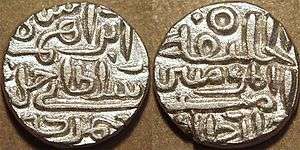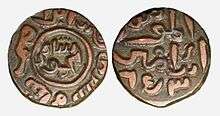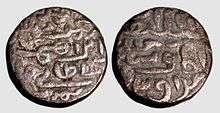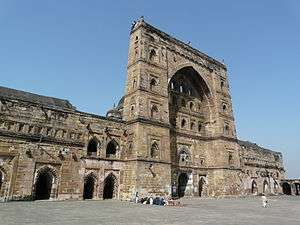Jaunpur Sultanate
The Jaunpur Sultanate was an independent Islamic empire in northern India between 1394 and 1479, whose rulers ruled from Jaunpur in the present day state of Uttar Pradesh. The Jaunpur Sultanate was ruled by the Sharqi dynasty. The Khwajah-i-Jahan Malik Sarwar, the first ruler of the dynasty was a wazir under Sultan Nasiruddin Muhammad Shah IV Tughluq (1390–1394). In 1394, amidst the disintegration of the Delhi Sultanate, he established himself as an independent ruler of Jaunpur and extended his authority over Awadh and a large part of the Ganges-Yamuna Doab and replaced much of the Delhi Sultanate. The dynasty founded by him was named so because of his title Mālik-us-Śarq ("ruler of the East"). The most notable ruler of the dynasty was Ibrahim Shah.
Jaunpur Sultanate جونپور سلطنت | |||||||||
|---|---|---|---|---|---|---|---|---|---|
| 1394–1479 | |||||||||
| Capital | Jaunpur | ||||||||
| Government | Monarchy | ||||||||
| History | |||||||||
• Established | 1394 | ||||||||
• Disestablished | 1479 | ||||||||
| |||||||||
History
Malik Sarwar, Khwajah-i-Jahan
In 1389, Malik Sarwar received the title of Khajah-i-Jahan. In 1394, he was appointed as the governor of Jaunpur and received his title of Malik-us-Sharq from Sultan Nasiruddin Mahmud Shah II Tughluq (1394 - 1413). Soon, he established himself as an independent ruler and took the title of Atabak-i-Azam. He suppressed the rebellions in Etawah, Koil and Kanauj. He was also able to bring under his control Kara, Awadh, Dalmau, Bahraich and South Bihar. The Rai of Jajnagar and the ruler of Lakhnauti acknowledged his authority and sent him a number of elephants. After his death, he was succeeded by his adopted son Malik Qaranfal, who took the title of Mubarak Shah.[1]
War with the Ujjainiyas of Bhojpur
During the reign of Malik Sarwar, Jaunpur became embroiled in a 100-year war with the neighbouring Ujjainiyas of Bhojpur in modern-day Bihar. The Ujjainiyas responded to the Jaunpur Sultan, Malik Sarwar disturbing Brahmins in their prayers. The Ujjainiya chieftain, Raja Harraj was initially successful in protecting these Brahmins and defeating the forces of Malik Sarwar however the Ujjainiyas were defeated in subsequent battles and forced to hide in the forests and resort to guerrilla warfare.[2]
Mubarak Shah
After assuming the power in 1399, Mubarak Shah struk coins in his own name and also the Khutba was read in his name. During his reign, Mallu Iqbal tried to recover Jaunpur, but failed. He was succeeded by his younger brother Ibrahim after his death in 1402,[1] who took the title of Shams-ud-Din Mubarak Shah.[3]
Ibrahim Shah

The Jaunpur Sultanate attained its greatest height under the younger brother of Mubarak Shah, who ruled as Shams ud-din Ibrahim Shah (ruled 1402-1440). To the east, his kingdom extended to Bihar, and to the west, to Kanauj; he even marched on Delhi at one point. Under the aegis of a Muslim holy man named Nur Qutb-ul-Alam, he threatened the Sultanate of Bengal under Raja Ganesha.[4]
Ibrahim Shah was a patron of Islamic learning and established a number of colleges for this purpose. A large number of scholarly works on Islamic theology and law was produced during his reign, which include the Hashiah-i-Hindi, the Bahar-ul-Mawwaj and the Fatwa-i-Ibrahim Shahi. He constructed a number of monuments in a new regional style of architecture known as the Sharqi. During his reign, Sultan Nasiruddin Mahmud Shah II Tughluq took refuge in Jaunpur in order to get rid of the control of Mallu Iqbal over him. But he did not treat Sultan Mahmud Shah well. As a result, his relations with the Sultan became bitter and Mahmud Shah occupied Kanauj. In 1407, he tried to recover Kanauj but failed. His attempt to conquer Bengal also failed. He was succeeded by his eldest son Mahmud Shah after his death.[1][3]
Mahmud Shah

Mahmud Shah was successful in conquering Chunar, but failed to capture Kalpi.[1] He also conducted campaigns against Bengal and Orissa. In 1452, he invaded Delhi but was defeated by Bahlul Lodi. Later, he made another attempt to conquer Delhi and marched into Etawah. Finally, he agreed to a treaty which accepted the right of Bahlul Lodi over Shamsabad. But when Bahlul tried to take possession of Shamsabad, he was opposed by the forces of Jaunpur. At this juncture, Mahmud Shah died and he was succeeded by his son Bhikhan, who assumed the title of Muhammad Shah.[5]
Muhammad Shah

On assuming power in 1457, Muhammad Shah made peace with Bahlul Lodi and recognised his right over Shamsabad. He picked up a quarrel with his nobles.[1] In 1458, after his brother Hasan was executed on his order, his another brother Hussain revolted and proclaimed himself as the sultan of Jaunpur, under the title of Hussain Shah. Muhammed Shah was soon killed by Hussain's army in Kanauj.[3]
Hussain Shah

The last ruler Hussain Shah signed a four years' peace treaty with Bahlul Lodi in 1458.[3] Later, in order to invade Delhi reached the banks of the Yamuna with a very large army in 1478. Sultan Bahlul Lodi tried to secure peace by offering to retain only Delhi and govern it as a vassal of Hussain Shah but he rejected the offer. As a result, Sultan Bahlul crossed the Yamuna and defeated him. Hussain Shah agreed for truce but again captured Etawah and marched towards Delhi with a huge army and he was again defeated by Bahlul Lodi. He was able to make peace this time also. In March 1479, he again arrived at the banks of Yamuna. He was again defeated by Bahlul Lodi and lost the Parganas of Kampil, Patiali, Shamsabad, Suket, Koil, Marhara and Jalesar to the advancing army of the Delhi Sultan. After the successive defeats in the battles of Senha, Rapri and Raigaon Khaga, he was finally defeated on the banks of the Rahab.[5] He fled to Bengal, where he was granted asylum by sultan Alauddin Husain Shah and spent his last days there.[3] In 1486, Bahlul Lodi placed his eldest surviving son Barbak Shah Lodi on the throne of Jaunpur. It was during Hussain Shah' rule that a claimant to be the mahdi of all muslims, Muhammad Jaunpuri, appeared and Hussain Shah was an admirer of him.
Art and architecture

The Sharqi rulers of Jaunpur were known for their patronage of learning and architecture. Jaunpur was known as the Shiraz of India during this period. Most notable examples of Sharqi style of architecture in Jaunpur are the Atala Masjid, the Lal Darwaza Masjid and the Jama Masjid. Though, the foundation of the Atala Masjid was laid by Firuz Shah Tughluq in 1376, it was completed only during the rule of Ibrahim Shah in 1408. Another mosque, the Jhanjhiri Masjid was also built by Ibrahim Shah in 1430. The Lal Darwaja Masjid (1450) was built during the reign of the next ruler Mahmud Shah. The Jama Masjid was built in 1470, during the rule of the last ruler Hussain Shah.
Music
The last ruler Hussain Shah assumed the title of Gandharva and contributed significantly in the development of Khayal, a genre of Hindustani classical music. He also composed several new ragas (melodies). Most notable among these are Malhār-śyāma, Gaur-śyāma, Bhopāl-śyāma, Hussaini- or Jaunpurī-āśāvari (presently known as Jaunpuri) and Jaunpuri-basant.
Rulers of Sharqi dynasty
| Titular Name | Personal Name | Reign | |
|---|---|---|---|
| Independence from Tughlaq dynasty of Delhi Sultanate | |||
| Khwajah-i-Jahan خواجہ جہاں Malik-us-Sharq ملک الشرق Atabeg-i-Azam اتابک اعظم |
Malik Sarwar | 1394 - 1399 C.E. | |
| Mubarak Shah مبارک شاہ |
Malik Qaranfal | 1399 - 1402 | |
| Shams-ud-Din Ibrahim Shah شمس الدین ابراہیم شاہ |
Ibrahim Khan | 1402 - 1440 | |
| Nasir-ud-Din Mahmud Shah ناصر الدین محمود شاہ |
Mahmud Khan | 1440 - 1457 | |
| Muhammad Shah محمد شاہ |
Bhi Khan | 1457 - 1458 | |
| Hussain Shah حسین شاہ |
Hussain Khan | 1458 - 1479 | |
| Reabsorbed in Delhi Sultanate under Lodi Dynasty | |||
Notes
- Mahajan, V.D. (1991, reprint 2007) History of Medieval India, Part I, S.Chand& Co., New Delhi, ISBN 81-219-0364-5, pp.264-66
- Md. Iftekhar Alam (1983). "The Relation of Bhojpur and Jaunpur (From 1389 A.D. to 1519 A.D)". Proceedings of the Indian History Congress. 44: 213. JSTOR 44139839.
- Majumdar, R.C. (ed.) (2006). The Delhi Sultanate, Mumbai: Bharatiya Vidya Bhavan, pp.186-92
- Goron and Goenka, p. 343.
- Mahajan, V.D. (1991, reprint 2007) History of Medieval India, Part I, S.Chand & Co., New Delhi, ISBN 81-219-0364-5, pp.247-49